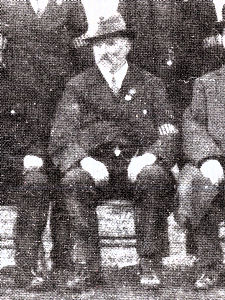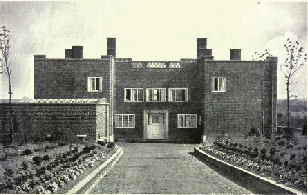|
William Wood Cook, Barley, 1907-1919 October, 2009 Correction March 2014 |
|
||||||
An architectural historian in Lancashire studying Edgar Wood asked for information about William Wood Cook and his connection with Dalny Veed, Barley. Information was exchanged and the following summarises the correspondence.
William Wood Cook (See Special Constables) >>>
William Wood(s) Cook (1851-1919) was born in Bolton, Lancashire, in 1851, the eldest son of James Cook, who in 1861 living at 169 Chorley New Road, Little Bolton and described as a cotton manufacturer employing 90 hands. James was the son of Joseph Cook and Ann Woods (marriage 1810, baptism 1814, both in St Peter, Bolton Le Moors).
In 1871 William was the manager of a cotton mill (at 20) and was living in Prospect House, Harwood, Bolton, Lancashire, with his parents James and Elizabeth, and younger siblings. Presumably he was the manager of nearby Prospect Mill. Nearby was a corn mill called Hardy Mill.
In 1878 William married Emily Mary Mills, daughter of Thomas Benjamin Mills (a grocer who died in 1857) and Rebecca Mills nee Beetham, in the Darlington area and in 1881 he was a cotton mill manager living in Clough Cottage, Crompton, Lancashire with his wife (26) and children Norman Ferguson Cook (2) and Evelyn Mary Cook (1). He was presumably the manager of Clough Mill, Mark Lane, Crompton (see link).
Shortly afterwards he left for Russian as in 1884 Amy Cook was born in Tyr (=Tver), Russia, (no later information about her found) while William Wood Cook (junior) was born 19 August 1893 at Tver, Russia (died 26 Oct 1981). In 1901 Norman was working as a machine fitter at Oldham and in 1903 he married in the Oldham area. In 1901 Evelyn was an art student in Kensington, London - while other members of the family could not be located in England.
Dalny Veed (Russian for "Pleasant View) was built in 1907, by the Lancashire architect, Edger Wood, and as William Wood Cook is recorded as being in residence in 1908 and because of the Russian name he commissioned it - presumably as a retirement home. He was there in 1911 with his wife and children William and Evelyn. Bill and Eva Cook joined the Barley hockey team (picture circa 1912) and when the First World War broke out William Wood Cook (senior) became a special constable (see picture above). William died in 1919, and his widow, Emily, in 1924. The Miss Cook who continued to live there was presumably Evelyn. By 1933 John Middleton Parker (who had previously lived at The Limes. Barley) had taken up residence, while Professor Kerr moved in circa 1935.
I was unable to find a direct reference to what William Wood Cook was doing in Russia, but I note that the online review of the book Russian Cotton Workers and the New Economic Policy states that the book "reveals the existence of a complex world of work that grew out of the interaction between the experience of the industrialization in late nineteenth and early twentieth century Russia and the mechanization of the cotton industry in late eighteenth and early nineteenth century Britain. " There are currently major cotton mills at Tver, and an online article "The Ryabushinskys" briefly mentions developments of the Tver Cotton Mill culminating in 1887. It therefore seems possible that William went to Tver in connection with the 1880s developments in the Russian cotton industry.
As William Wood Cook had a Lancashire Wood ancestor and the architect Edgar Wood, also came from Lancashire my questioner provided some background information:
Edgar Wood was the son of a mill owner, Thomas Broadbent Wood. His father, moved to Middleton from next door Rochdale. The Woods in Rochdale were involved in banking and T. B. was one of the original commissioners of both Rochdale and Middleton. He was very interested in public life and was a prominent Unitarian.
Edgar was an artist/architect who designed buildings, painted and made furniture and metal work in the William Morris tradition. He was a designer of domestic buildings, which were then all the rage for the artistically minded. Dalney Veed is one of his most important works, a pioneering modern movement building. His great achievement, in my opinion, was to synthesize the formal, the picturesque and the technological into a new style which subsequently became the inter-war modern style. He was also revolutionizing decoration, dropping the floral and natural of the Victorian era for the angular and geometrical which was to become the Art Deco of the 1920s and 30s. One has to travel to Vienna and see the work of the Secessionist architects, such as Josef Hoffmann, Joseph Olbrich and Adolf Loos to find anything similar to Dalney Veed and Upmeads (his other famous house in Stafford) and I believe Wood must have been liaising with these architects at the time.
The only other Wood house in South East England is Snelsmore House (link) at Shaw Cum, Donnington, West Berkshire, which is now the Donnington Valley Golf Club. His buildings are largely confined to the Greater Manchester and Huddersfield areas, the home areas of his father and mother's families (Sykes). Many of his commissions were from family or friends and there are a few Woods recorded as clients who don't seem to be related. One example is Robert Jonathon Wood mill owner in the village of Birch, which lies in Middleton but quite close to Heywood. Another recently discovered is Edward Wood who bought a very large old house, Newbold Revel near Rugby and which Edgar altered and extended in the late 1890s.There is also an Edgar Wood website and David Morris has written an excellent leaflet The Buildings of Edgar Wood in Middleton Town Centre.
In these circumstances it seems very likely that William's decision to use Edgar Wood (1860-1935) as an architect was due to a family or friend connection. A quick provisional search showed that Edgar's father, Thomas Broadbent Wood (1821-1909), was baptised at Blackwater Street Presbyterian Church, Rochdale, son of Joseph Wood and Mary Lord, who had married at St Chad, Rochdale, in 1818. Joseph Wood was probably the Joseph Wood who was baptised at Rochdale in 1787, the son of John Wood and Mary Hartley (said to have married at Rochdale in 1781). A Hannah Wood, the daughter of John and Mary Wood, was baptised at the Cathedral, Manchester in 1785, which suggests that Ann Woods, who was the grandmother of William Wood Cook, could have been the brother of Joseph, grandfather of Edgar Wood. This would make William Wood Cook second cousin to Edgar Wood.
Information comes from usual genealogy sources (Ancestry, various directories, FreeBMD, familysearch, etc. but certificates, etc., have not been checked) plus Google and the book Barley - An English Village.



